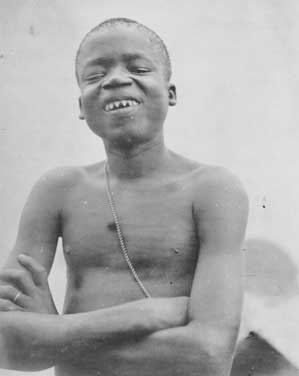الفرق بين المراجعتين لصفحة: «Human tooth sharpening»
ط (مراجعة واحدة) |
(لا فرق)
|
المراجعة الحالية بتاريخ 04:06، 14 نوفمبر 2016


Human tooth sharpening is the practice of manually sharpening the teeth, usually the front incisors. Filed teeth are customary in various cultures. Many remojadas figurines found in part of Mexico have filed teeth and it is believed to have been common practice in their culture. The Zappo Zap people of the Democratic Republic of Congo are believed to have filed their teeth.
Historically it was done for spiritual purposes, with some exceptions, but in modern times it is usually aesthetic in nature as an extreme form of body modification.[1]
History
Many cultures have practiced this form of body modification. In Bali, teeth were filed down because it was thought that the teeth represented anger, jealousy, and other similar negative emotions. The teeth were also sharpened as a rite of passage for adolescents.[1] Teeth filing was also used by Aborigines for spiritual reasons, as well as assorted Vietnamese and Sudanese tribes. In Mayan culture, the teeth were sharpened, and sometimes had designs carved into them, to distinguish those in the upper-classes. Many cultures would sharpen their teeth to imitate animals, such as the Wapare of intertropical Africa, who sharpened their teeth to imitate sharks, as well as kicking out some mandibular teeth during puberty.[2] In Ancient China, a group called Ta-ya Kih-lau (打牙仡佬, literally 仡佬 (Gelao people) who beat out their teeth"[3]) had every woman about to wed knock out two of her anterior teeth to "prevent damage to the husband's family."[3] Some cultures have distinctions between which sex does what to their teeth. In the central Congo region, the Upoto tribe has men file only teeth in the maxillary arch, whereas women file both maxillary and mandibular arches.[4] The Mentawai people have also traditionally engaged in this practice.[5]
Examples in the modern world
- Ota Benga was a Congolese pygmy imported to a zoo in the United States whose front teeth were sharpened when he was a young boy.
- Horace Ridler, "the Zebra man", included tooth sharpening as one of many bodily modifications he underwent in order to serve as a circus performer.
References
- ↑ 1٫0 1٫1 DeMello, Margo (2007). Encyclopedia of Body Adornment (Illustrated ed.). Greenwood Publishing Group. p. 81. ISBN 0-313-33695-4.
- ↑ Frazer, James George (2006). Totemism and Exogamy: A Treatise on Certain Early Forms of Superstition and Society. 4. Kessinger Publishing. p. 191. ISBN 1-4254-9924-4.
- ↑ 3٫0 3٫1 Frazer, James George (2006). Totemism and Exogamy: A Treatise on Certain Early Forms of Superstition and Society. 4. Kessinger Publishing. p. 187. ISBN 1-4254-9924-4.
- ↑ Frazer, James George (2006). Totemism and Exogamy: A Treatise on Certain Early Forms of Superstition and Society. 4. Kessinger Publishing. p. 193. ISBN 1-4254-9924-4.
- ↑ Ver Berkmoes, Ryan (2010). Indonesia (eBook ed.). Lonely Planet Publications. p. 428. ISBN 1-74104-830-3.